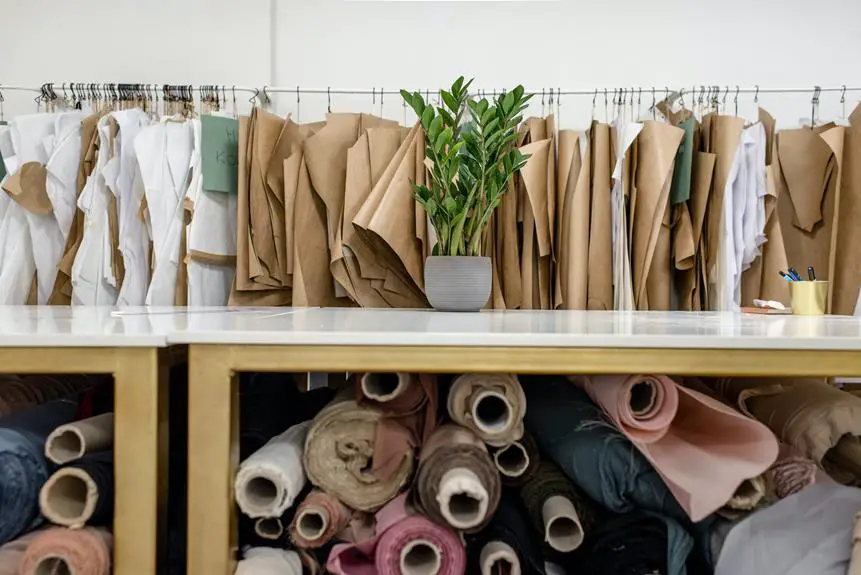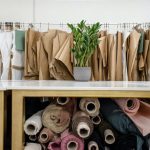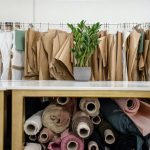When it comes to choosing the perfect fabric, the decision between modal and lyocell can leave you pondering. Both fabrics offer unique qualities that make them stand out in the world of textiles. Understanding the nuances of each can help you make an informed choice, tailored to your specific needs.
In this comparison, we'll delve into the characteristics of modal and lyocell, examining their production processes, comfort, environmental impact, durability, and suitability for various applications. By the end, you'll be equipped to determine which fabric reigns supreme for your individual preferences and requirements.
Let's unravel the intricacies of modal vs. lyocell to empower your fabric selection mastery.
Key Takeaways
- Modal and Lyocell are both sustainable alternatives to traditional cotton, derived from different types of trees.
- Lyocell has a closed-loop production process, resulting in minimal environmental impact, while Modal may involve a slightly more resource-intensive process.
- Both fabrics offer comfort, breathability, and moisture-wicking properties, making them suitable for various settings, including activewear and undergarments.
- Modal is well-suited for activewear, loungewear, and undergarments, while Lyocell is ideal for denim, workwear, and home textiles.
The Origins of Modal and Lyocell
When considering the origins of Modal and Lyocell, you should start by understanding the production processes of these two fabrics.
Modal is a type of rayon, derived from beech trees, particularly the European beech. The pulp used to create Modal is harvested from sustainable beech tree plantations, making it a renewable and eco-friendly resource.
Lyocell, on the other hand, is also a form of rayon, but its fiber is sourced from eucalyptus trees. The eucalyptus trees used in Lyocell production are grown on marginal land unsuitable for food crops and require minimal irrigation.
Both Modal and Lyocell are considered to be more sustainable alternatives to traditional cotton due to their production processes and the types of trees used.
In terms of environmental impact, both fabrics have their advantages. Modal is known for its efficient use of water and low environmental impact. However, the chemical processing involved in its production raises some environmental concerns.
On the other hand, Lyocell is manufactured through a closed-loop process, meaning that the solvents and chemicals used are recycled with minimal waste. This gives Lyocell an edge in terms of environmental sustainability.
When comparing the fiber origins and environmental impact of Modal and Lyocell, it's clear that both fabrics have their strengths, offering environmentally conscious consumers viable options.
Production Process Comparison
When comparing the production processes of Modal and Lyocell, it's essential to consider factors such as sustainability and efficiency. Understanding how these fabrics are manufactured can shed light on their environmental impact and overall quality.
Let's explore the production methods of both fabrics to determine which one reigns supreme in terms of production process.
Modal Vs. Lyocell Production
You can distinguish the production processes of modal and lyocell by examining their respective methods and environmental impact.
Modal is derived from beech trees using a closed-loop process, where 99% of the chemicals used are recovered and recycled. This results in a relatively low environmental impact. The production efficiency of modal is noteworthy due to the high yield of fiber per acre of beech trees.
On the other hand, lyocell, also known as Tencel, is produced using a solvent spinning process, which is considered more environmentally friendly than other methods. Lyocell production is highly efficient as it uses renewable wood sources and the solvent-spinning process is designed to minimize waste.
Both fabrics have their own environmental benefits and production efficiencies, making them sustainable choices for the conscious consumer.
Sustainability and Efficiency
Comparing the sustainability and efficiency of the production processes for modal and lyocell reveals their distinct environmental impacts and resource utilization.
Sustainability Benefits
Both modal and lyocell are considered sustainable fabrics, but their production processes differ in terms of environmental impact. Lyocell, made from eucalyptus trees, is known for its closed-loop production, where the solvents and water used are recycled, resulting in minimal environmental impact. On the other hand, modal, derived from beech trees, also boasts sustainability benefits but may involve a slightly more resource-intensive process.
Material Efficiency
In terms of material efficiency, lyocell's production process stands out for its minimal waste and efficient use of resources. The closed-loop system in lyocell production ensures that the raw materials are utilized with minimal waste, making it a more resource-efficient choice compared to modal.
Comfort and Feel Comparison
When comparing the comfort and feel of modal and lyocell, it's important to consider the distinct characteristics of each fabric.
Modal is known for its silky smoothness, offering a luxurious sensation against the skin.
On the other hand, lyocell boasts a unique softness that provides a comfortable and cozy experience.
Both fabrics are praised for their breathability and moisture-wicking properties, enhancing overall comfort in various settings.
Modal's Silky Smoothness
Experiencing the silky smoothness of modal fabric will leave you amazed at its unparalleled comfort and luxurious feel. Modal's fibers are exceptionally soft, making it a top choice for those who prioritize comfort. Here's why you'll love the silky smoothness of modal:
- Breathability: Modal's breathability ensures that the fabric feels light and airy against your skin, providing a sensation of cool comfort even in warmer climates.
- Moisture Absorption: Modal's moisture-wicking properties help to keep you dry and comfortable by efficiently absorbing and releasing moisture, making it an ideal choice for activewear and undergarments.
- Drape and Flow: The fabric's natural drape and flow give garments a graceful, elegant appearance, enhancing the overall comfort and feel of the clothing.
Modal's luxurious, silky smooth texture, combined with its practical benefits, makes it a fabric worth experiencing.
Lyocell's Luxurious Softness
You'll find Lyocell's luxurious softness to be a delightful contrast to modal's silky smoothness, offering a unique blend of comfort and elegance. When comparing the luxurious comfort of Lyocell with other fabrics, it becomes evident that Lyocell stands out. The fabric's incredibly soft feel against the skin provides a sensation of unparalleled luxury, making it a preferred choice for those who appreciate both comfort and style. Below is a comparison table highlighting the key differences in comfort and feel between Lyocell and modal.
| Aspect | Lyocell | Modal |
|---|---|---|
| Softness | Luxuriously soft, smooth, and gentle | Silky smooth and exceptionally supple |
| Comfort | Provides a luxurious and comforting feel | Offers a comforting and soothing sensation |
| Elegance | Combines comfort with an elegant touch | Balances comfort with a refined appearance |
This comparison demonstrates how Lyocell excels in providing luxurious comfort, making it a fabric of choice for those seeking the ultimate in comfort and elegance.
Breathability and Moisture-Wicking
Achieving optimal breathability and moisture-wicking is essential for evaluating the comfort and feel of both modal and Lyocell fabrics.
When it comes to breathability, both modal and Lyocell excel in allowing air to pass through the fabric, keeping you cool and comfortable.
However, Lyocell's structure provides slightly better moisture-wicking properties, effectively drawing sweat away from the skin and promoting evaporation, giving a drier feel.
On the other hand, modal also offers commendable moisture-wicking capabilities, ensuring a pleasant sensation during physical activities or warmer weather.
Both fabrics present high breathability and moisture-wicking attributes, contributing to an overall comfortable and pleasant wearing experience.
Understanding these subtle differences can help you make an informed decision based on your specific comfort and feel preferences.
Environmental Impact Assessment
When considering the environmental impact of modal and lyocell fabrics, you should assess their production processes and resource usage.
Both modal and lyocell are considered eco-friendly fabrics due to their manufacturing techniques. Modal is derived from beech trees, and the production process involves using eco-friendly chemicals in a closed-loop process, making it relatively sustainable.
Conversely, lyocell, also known as Tencel, is made from eucalyptus trees, which are known for their low water and pesticide requirements. The closed-loop production of lyocell also minimizes environmental impact.
In terms of resource usage, both fabrics require significantly less water and land compared to conventional cotton production. However, the chemical processing involved in creating these fabrics raises concerns about potential environmental impact, particularly in terms of chemical discharge and energy use.
While both fabrics have eco-friendly attributes, further research and development are necessary to mitigate any potential negative effects of their production processes. Therefore, it's important to continue monitoring and improving the manufacturing processes of both modal and lyocell to ensure their overall environmental sustainability.
Durability and Performance Evaluation
To evaluate the durability and performance of modal and lyocell fabrics, consider their resistance to wear and tear as well as their ability to maintain shape and color over time. When assessing durability, it's essential to examine the fabric's resilience and how well it withstands repeated use and laundering. Performance in wear encompasses factors such as breathability, moisture-wicking properties, and overall comfort during extended wear.
Here are crucial aspects to consider in the durability assessment and performance in wear of modal and lyocell fabrics:
- Tensile Strength: Both modal and lyocell fabrics boast high tensile strength, making them durable and resistant to tearing or ripping, ensuring longevity and reliability in various applications.
- Color Retention: Modal and lyocell fabrics exhibit excellent color retention, retaining their vibrant hues even after multiple washes, ensuring long-lasting aesthetics and visual appeal over time.
- Wrinkle Resistance: Modal and lyocell fabrics have inherent wrinkle-resistant properties, maintaining a smooth and neat appearance even after prolonged use, enhancing their suitability for everyday wear.
When evaluating the durability and performance in wear of fabrics, modal and lyocell showcase exceptional attributes that make them ideal choices for enduring and high-performing garments.
Suitability for Different Applications
The fabrics' suitability for different applications depends on their specific characteristics and performance, allowing you to make informed choices based on your needs and preferences.
When it comes to applications comparison, modal and lyocell each have distinct advantages.
Modal, known for its exceptional softness and moisture-wicking properties, is well-suited for activewear, loungewear, and undergarments. Its ability to remain soft and breathable even after multiple washes makes it a top choice for these applications.
On the other hand, lyocell, with its superior strength and absorbency, is ideal for more heavy-duty applications such as denim, workwear, and home textiles. Its durability and ability to hold vibrant colors make it a preferred option for these types of products.
When conducting a performance assessment, consider the specific demands of the intended use. For instance, if you prioritize comfort and flexibility, modal may be the better choice. However, if durability and color retention are key factors, lyocell could be the superior option.
Modal Vs Lyocell: Making the Ultimate Choice
For your ultimate choice between modal and lyocell, carefully weigh their specific qualities and consider your priority for comfort, durability, and color retention.
When making the ultimate choice between modal and lyocell, consider the following:
- Modal's Versatility: Modal fabric is known for its versatility, offering a luxurious softness that makes it ideal for clothing items that require a comfortable and elegant drape. Its ability to hold color well also makes it a great option for vibrant and long-lasting clothing.
- Lyocell's Eco-Friendly Properties: Lyocell, on the other hand, is celebrated for its eco-friendly production process. Made from sustainable wood pulp, lyocell is biodegradable and its production utilizes less water and energy compared to other fabrics. If sustainability is a key factor in your decision-making process, lyocell may be the fabric of choice.
- Balancing Comfort, Durability, and Environmental Impact: Ultimately, your decision may hinge on whether you prioritize comfort and color retention (modal) or eco-friendliness and durability (lyocell). Understanding these key differences will empower you to make the ultimate choice between modal and lyocell.
Frequently Asked Questions
Are There Any Special Care Instructions for Modal and Lyocell Fabrics?
For both modal and lyocell fabrics, special care is essential. Follow specific washing instructions to maintain fabric durability. Consider environmental impact and sustainability, as these fabrics are sourced from renewable materials.
Can Modal and Lyocell Fabrics Be Dyed Easily at Home?
Yes, both modal and lyocell fabrics can be dyed easily at home. Their properties make them receptive to various dyeing techniques. Modal absorbs color well, while lyocell has high color retention.
What Are the Potential Health Benefits of Choosing Modal or Lyocell Fabrics?
When considering potential benefits, both modal and lyocell fabrics offer comfort and durability. They also have a positive environmental impact. Their breathable and moisture-wicking properties make them great choices for your health.
Are There Any Specific Brands or Manufacturers That Are Known for Producing High-Quality Modal or Lyocell Fabrics?
When it comes to sustainable fashion and ethical production, several brands excel in manufacturing high-quality modal or lyocell fabrics. These fabrics are known for their durability, comfort, and softness, and brands like X and Y are at the forefront of this movement.
How Do Modal and Lyocell Compare in Terms of Moisture-Wicking and Temperature-Regulating Properties?
When it comes to moisture-wicking and temperature regulation, both modal and lyocell excel. They efficiently manage moisture and adapt to your body's temperature. Additionally, they are eco-friendly and durable, making them great options for various uses.
- Tetron Fabric for Marine Applications: Durability and Use Cases - June 18, 2025
- Tetron Fabric for Outdoor Furniture: Weather Resistance and Care - June 18, 2025
- Tetron Fabric for Wall Coverings: Style and Application Tips - June 18, 2025





